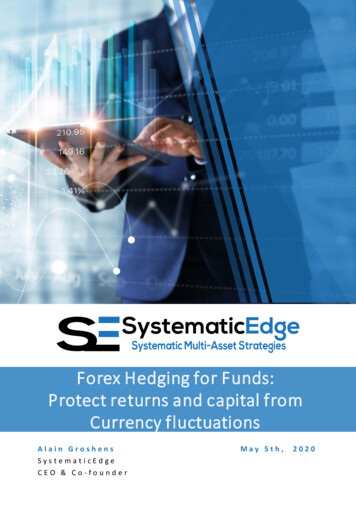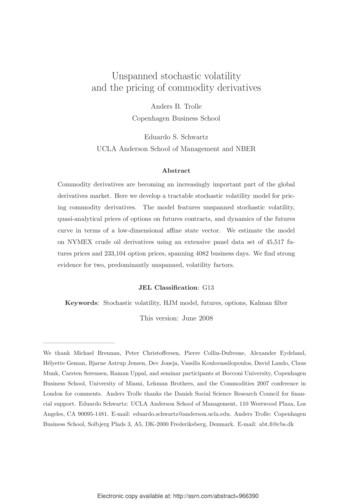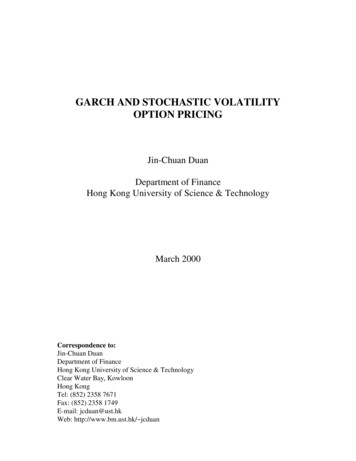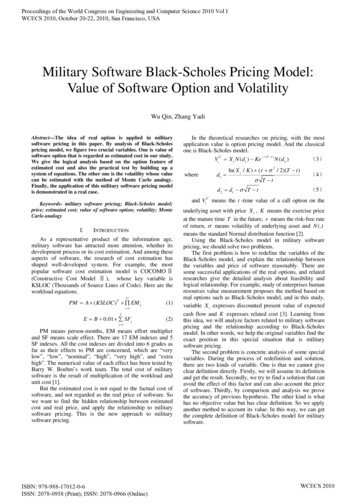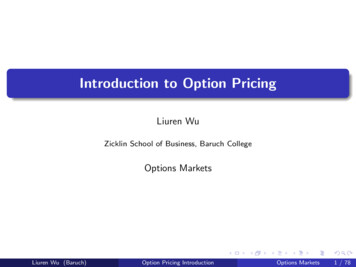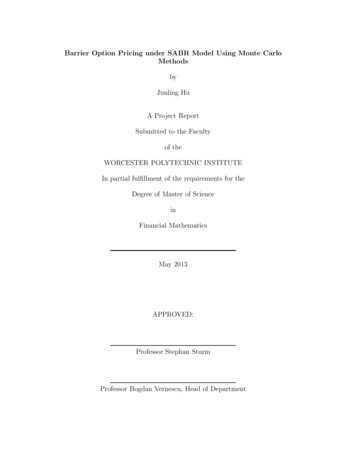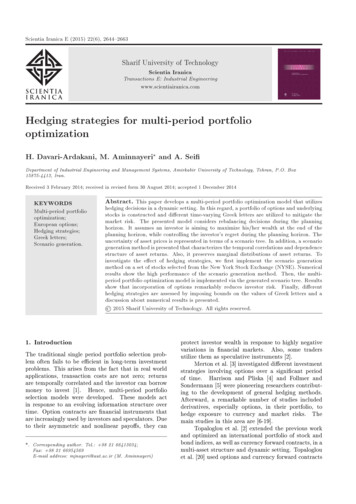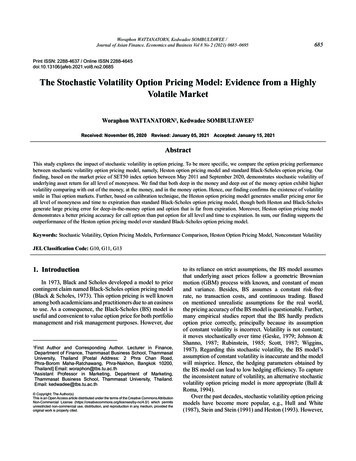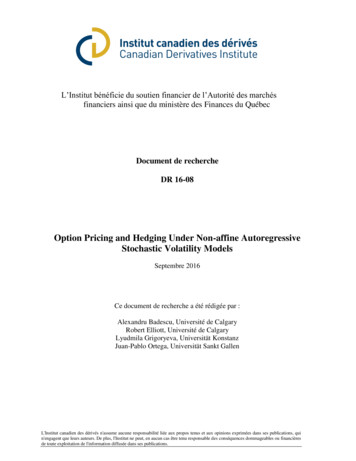
Transcription
L’Institut bénéficie du soutien financier de l’Autorité des marchésfinanciers ainsi que du ministère des Finances du QuébecDocument de rechercheDR 16-08Option Pricing and Hedging Under Non-affine AutoregressiveStochastic Volatility ModelsSeptembre 2016Ce document de recherche a été rédigée par :Alexandru Badescu, Université de CalgaryRobert Elliott, Université de CalgaryLyudmila Grigoryeva, Universität KonstanzJuan-Pablo Ortega, Universität Sankt GallenL'Institut canadien des dérivés n'assume aucune responsabilité liée aux propos tenus et aux opinions exprimées dans ses publications, quin'engagent que leurs auteurs. De plus, l'Institut ne peut, en aucun cas être tenu responsable des conséquences dommageables ou financièresde toute exploitation de l'information diffusée dans ses publications.
Option pricing and hedging under non-affineautoregressive stochastic volatility modelsAlexandru Badescu1 , Robert Elliott2 , Lyudmila Grigoryeva3 , and Juan-Pablo Ortega4, 5AbstractNew pricing and hedging strategies are proposed for a non-affine auto-regressive stochastic factormodel with non-predictable drift which allows to account for leverage effects. We consider a volatilitydependent exponential linear pricing kernel with stochastic risk aversion parameters and implementboth pricing and hedging for these models estimated via the hierarchical-likelihood method. Thistechnique proves to outperform standard GARCH and Heston-Nandi based strategies in terms of avariety of considered criteria in an empirical exercise using historical returns and options data.Keywords: autoregressive stochastic volatility models, bivariate Esscher transform, option pricing, localrisk minimization hedging, h-likelihood estimation.JEL Classification: C58, G13.1 Departmentof Mathematics and Statistics, University of Calgary, Calgary, Canada.School of Business, University of Calgary, Calgary, Canada.3 Department of Mathematics and Statistics. Graduate School of Decision Sciences. Universität Konstanz. Box 146.D-78457 Konstanz. Germany.4 Department of Mathematics and Statistics. Universität Sankt Gallen. Bodanstrasse 6. CH-9000 Sankt Gallen. Switzerland.5 Centre National de la Recherche Scientifique (CNRS). Laboratoire de Mathmatiques de Besançon. Univ. BourgogneFranche-Comté. 16, route de Gray, F-25030 Besançon. France.2 Haskayne1
Option pricing and hedging under non-affine autoregressive stochastic volatility models12IntroductionEmpirical findings show strong evidence against several assumptions of the Black-Scholes (1973) optionvaluation model. The pricing and hedging of index options have been thus extensively studied in thecontext of stochastic volatility (SV) models in both discrete and continuous time.In discrete-time settings, there are two main approaches for modeling the well documented volatilitysmile/smirk. The first direction is represented by the family of Generalized Autoregressive ConditionallyHeteroskedastic (GARCH) models introduced by Engle (1982) and Bollerslev (1986), which have becomevery popular due to their ability to capture several of the “stylized facts” observed in financial markets,such as volatility clustering, fat tails, leverage effects, etc. Duan (1995) proposed a GARCH optionpricing model driven by Gaussian innovations and based on a stochastic discount factor (SDF) whichcontains only a market price of equity risk. Due to its non-affine structure, there are no closed-formsolutions available for pricing European style options. An alternative approach was provided by Hestonand Nandi (2000), who introduced an affine class of Gaussian GARCH models which admit a semiclosed form expression for the unconditional Laplace transform of the log-asset price process. In orderto improve the empirical fit of the Gaussian GARCH model, several extensions have been proposedin the literature, by including skewed and heavy-tailed innovations (see for instance Christoffersen etal. (2006), Chorro et al. (2012) and Badescu et al. (2008)), realized volatility measures (see, for example,Stentoft (2008), Hansen et al. (2011), Corsi et al. (2013) and Christoffersen et al. (2014)), multi-factorvolatility dynamics (see Christoffersen et al. (2008) and Majewski et al. (2015)), variance dependentpricing kernels (see Christoffersen et al. (2013), Bormetti et al. (2015)) or combinations of the above (seeBabaoglu et al. (2014) and Badescu et al. (2015)).The second class consists of the Autoregressive Stochastic Volatility (ARSV) models (see Taylor (1986), Harvey et al. (1994) and Taylor (2005)), which can be viewed as discretizations of continuoustime SV models as they allow for separate driving noises for the asset-returns and the volatility/factorprocesses. Even though they provide more flexible dynamics than their GARCH counterparts, theARSV models have not been as popular in terms of pricing and hedging financial derivatives, mainlydue to estimation related issues, and only recently they got some attention by the research community.For example, Darolles et al. (2006) introduced the Compound Autoregressive (CAR) process which,equipped with an exponential affine pricing kernel, has been used for derivative valuation by Bertholonet al. (2008). The CAR framework has been extended by Khrapov and Renault (2014) who proposed anaffine bivariate model for asset returns variance which allows for leverage effect and volatility feedback.Discrete-time affine stochastic volatility models with conditional skewness have been considered in Feunou and Tédongap (2012). They propose an ARSV option pricing model based on conditional InverseGaussian returns and autoregressive Gamma latent factors (see also Gourieroux and Jasiak (2006)).They show that these option pricing models outperform existing affine GARCH and continuous timejump diffusion models. However, the model parameters cannot be estimated using information coming
Option pricing and hedging under non-affine autoregressive stochastic volatility models3from returns and options, since there is no existing link between the physical and the risk-neutral worlds.The key ingredient in deriving pricing expressions in all aforementioned studies is the affine structureof the underlying models. However, the (affine) constraints typically imposed in the conditional meanreturn and volatility dynamics are somewhat restrictive. For example, Khrapov and Renault (2014)suppose that both the conditional Laplace transform of the variance process and the bivariate Laplacetransform of the asset returns and variance process have an exponential affine form. Although thisassumption leads to explicit or semi-explicit pricing formulae, there are not many distribution candidatesfor the driving noise process which satisfy the required condition. For instance, their empirical analysisis based on just one model constructed using a conditional Gaussian distribution for the asset returnsand an autoregressive Gamma process for the latent factor. Another drawback of the affine models isthat the exponential pricing kernel associated to the pricing methodology is typically based on constantequity and variance risk preference parameters, which is not consistent with empirical findings.In order to address some of these issues, this paper proposes a simple one-factor non-affine ARSVoption pricing model which allows for stochastic prices of risk and leverage effect. Our construction isbased on a conditional Gaussian distribution for the factor process which drives both the conditionalmean and variance of the asset returns. As in the affine modeling literature, we use an exponentialpricing kernel which, in our situation, contains stochastic equity and factor risk premiums. Moreover,we show that having both risk premiums constant at the same time is not consistent with our setting,and that the market price of factor risk has a linear dependence of the factor process. We show that,unlike in the affine setting of Khrapov and Renault (2014), the risk-neutral bivariate Laplace transformhas an exponential quadratic form in the latent factor. Moreover, our change of measure preserves theconditional distribution of the factor process, but not that of the asset returns.Since the unconditional risk-neutral Laplace transform of the asset returns cannot be computedexplicitly, and consequently a (spectral) generalized method of moments (GMM) estimation cannot beobtained using standard methods, we propose a sequential estimation procedure based on the informationon both asset returns and option prices. First, using historical returns, we estimate the model parametersfollowing the hierarchical likelihood (h-likelihood) technique proposed by Lee and Nelder (1996) andapplied in the context of ARSV models by Lim et al. (2011). This method consists of performing alikelihood estimation in which the unobserved factor values are treated as unknown parameters in theoptimization problem. In the second stage, the pricing kernel parameters are estimated based on the crosssection of options written on the same underlying. We conduct an extensive empirical analysis to test thepricing and hedging performance of our model for a large panel of European put and calls options. Thebenchmark used in our analysis is the Heston and Nandi (2000) affine GARCH model. The option pricesare computed based on Monte-Carlo simulation of weighted payoffs under the real-world measure, wherethe weights are given by the Radon-Nikodym derivatives of the corresponding measure change. Followingthe approach developed by Föllmer and Sondermann (1986), the hedging ratios are computed using thelocal risk minimization with respect to this risk-neutral measure. To facilitate the empirical comparison,
Option pricing and hedging under non-affine autoregressive stochastic volatility models4we implement a similar estimation procedure for the affine GARCH model. Our results show that theARSV model consistently outperforms its GARCH counterpart for almost all classes of moneyness andmaturity considered. The overall Implied Volatility Root Mean Squared Error (IVRMSE) is improvedby 24% in-sample and by 12% out-of-sample (in a weekly basis pricing exercise). Moreover, we noticethat the average improvement in IVRMSE for in-the-money calls is around 34% in-sample and 26% forthe out-of-sample weekly basis exercise. The only case when the GARCH performs slightly better thanthe ARSV is for long-term out-of-money contracts. Finally, a similar finding is revealed by the hedgingexercise in the sense that the ARSV outperforms both the GARCH and the Black-Scholes model for allmaturities and moneyness groups. The overall improvement over GARCH, as measured by a NormalizedHedging Error (NHE) indicator, is of 28%.The paper is organized as follows. In Section 2 we introduce the underlying discrete-time stochastic volatility model. The pricing kernel and risk-neutral derivations are presented in Section 3. Theestimation methodology and the numerical results are illustrated in Section 4. Section 5 concludes thepaper.Acknowledgments: We acknowledge partial financial support of the Institut de la finance structurée etdes instruments dérivés de Montréal (IFSID) that generously sponsored this project and made possiblethe collaboration between the authors of this report.2A non-affine one-factor autoregressive SV modelConsider a discrete time economy with the set of trading dates T {t t 0, 1 . . . , T }, where T representsthe terminal time. We assume that the market consists of a bond and a stock with corresponding priceprocesses denoted by B : {Bt }t T and S : {St }t T , respectively. Let r be the instantaneous constantrisk free rate of return and assume that bond price dynamics is given by:Bt ert , t T ,B0 1.The log-return process, defined by y : {yt }t T {log St /St 1 }t T , is governed by the following onefactor autoregressive stochastic volatility model:yt µ λft2 ft t , t N(0, 1),(2.1)ft γ φft 1 ωt ,ωt N(0, σω2 ).(2.2)We use the following assumptions and notations:(1) The return process y : {yt }t T represents the observable quantity, while f : {ft }t T is an
Option pricing and hedging under non-affine autoregressive stochastic volatility models5unobservable one-dimensional latent factor process.6(2) The innovations : { t }t T and ω : {ωt }t T are two sequences of i.i.d. Gaussian randomvariables which are both serially independent and also independent of each other.(3) The model parameter vector is denoted by θ : (µ, λ, γ, φ, σω ) R5 and is assumed to satisfystandard stationarity conditions.(4) Let (Ω, P ) be the probability space under which the model (2.1)-(2.2) has been introduced; werefer to P as the physical (real-world) probability measure. We denote by Ft : σ (ys , fs ; s t) thesigma-algebra generated by both the return and the factor processes, and introduce the augmentedSfiltration Gt : σ (ys , fs , ft ; s t 1) Ft 1 {ft }.We notice that yt is Ft -measurable, but it is not Gt -measurable, while, ft is measurable with respect toboth filtrations. Furthermore, the noise processes t is independent of Gt and wt is independent of Ft 1 .From equations (2.1)-(2.2), we can conclude that the asset returns are conditionally Gaussian distributedgiven Gt , that is, Pyt Gt N µ λft2 , ft2 ,(2.3)while the latent factor ft has an Ft 1 -conditional Gaussian distribution, namely, Pft Ft 1 N mt 1 , σω2 ,(2.4)with mt γ φft .We start by evaluating the joint cumulant generating function of the asset return and the factorprocess, conditionally on the information set Ft .Proposition 2.1 If the asset returns follow the dynamics in (2.1)-(2.2), then the Ft 1 -conditional bivariate cumulant generating function of yt and ft under P is given by:PC(y(z1 , z2 Ft 1 ) : log EP [exp (z1 yt z2 ft ) Ft 1 ] z1 µ t ,ft )v (z2 , mt 1 ) m2t 11log u(z1 ) . (2.5)2u(z1 )2σω2Here, u(·) and v(·, mt ) are two real-valued functions given by:u(z1 )v(z2 , mt )1 z1 (z1 2λ) σω2 , 2σω2mt z2 2,2σω (2.6)(2.7)which satisfy the conditions u(0) 1 and v(0, mt ) m2t /(2σω2 ).PNote that C(y(z1 , z2 Ft 1 ) is well defined only for the values z1 such that z1 (z1 2λ) σω2 1 andt ,ft )that, furthermore, it is not an affine function of the factor process. In fact, if we expand mt 1 in (2.5), we6 This setting can be easily extended to the multi-factor case. In order to keep the presentation simple, we restrict ourattention to the one-factor setup.
Option pricing and hedging under non-affine autoregressive stochastic volatility models6Pobserve that C(y(z1 ,z2 Ft 1 ) has a quadratic dependence with respect to ft 1 . We now characterizet ,ft )the univariate conditional cumulant generating functions of yt and ft . Indeed, taking z1 0 in (2.5), itis easy to verify that the Ft 1 -conditional cumulant generating function of the latent factor correspondsto that of a Gaussian random variable with mean mt 1 and variance σω2 :1P(0, z2 Ft 1 ) z2 mt 1 z22 σω2 .CfPt (z2 Ft 1 ) C(yt ,ft )2(2.8)Similarly, the cumulant generating function of yt conditionally on Ft 1 can be obtained from (2.5) asfollows:CyPt(z1 Ft 1 ) PC(yt ,ft )m21(z1 , 0 Ft 1 ) z1 µ log u(z1 ) t 122σω2 1 1 .u(z1 )(2.9)Taking the first and the second order derivatives of CyPt (z1 Ft 1 ) evaluated at z1 0, we obtain theconditional mean and variance of the asset returns under the physical measure:EP [yt Ft 1 ]VarP [yt Ft 1 ] µ λ m2t 1 σω2 ,(2.10) m2t 1 σω2 2λ2 σω2 2m2t 1 σω2 .(2.11)The conditional covariance between the asset return process and the latent factor is given by:CovP (yt , ft Ft 1 ) 2λmt 1 σω2 .(2.12)Finally, we can compute the covariance between the asset return process and its one-step ahead conditional variance given the information set Ft 1 as: CovP yt , VarP [yt Ft 1 ] Ft 1 2λφσω2 (1 4λ2 σω2 ) 2γmt 1 φ 2m2t 1 σω2 .(2.13)Thus, both parameters λ and φ contribute to the leverage effect.3Pricing kernel and risk-neutral dynamicsThe choice of the risk-neutral measure plays an important role in the pricing and hedging of financialderivatives. In this section we introduce an exponential linear pricing kernel via a bivariate conditionalEsscher transform.First, for any t T , we define the following stochastic process N {Nt }t T : PNt exp η1t yt η2t ft C(y(η1t , η2t Ft 1 ) .t ,ft )(3.1)Here, η1t {η1t }t T and η2t {η2t }t T are two Ft -predictable processes representing the market pricesof equity risk and factor risk, respectively. Similar stochastic discount factors have been proposed in the
Option pricing and hedging under non-affine autoregressive stochastic volatility models7context of discrete-time stochastic volatility models (see e.g. Khrapov and Renault (2014) and Bormettiet al. (2015) among others), but only with constant market prices of risk. However, as showed later inthis section, it is not possible to have both η1t and η2t constants in our setting.The pricing measure Q is introduced through the following Radon-Nikodym derivative process denoted by Z {Z}t T :dQdPFT: ZT TYNt t 1TY Pexp η1t yt η2t ft C(y(η1t , η2t Ft 1 ) .t ,ft )(3.2)t 1It is straightforward to check that Q is an equivalent probability measure with respect to P . Indeed, wefirst notice that Zt defined in (3.2) with Z0 1 is an Ft -martingale:h iPEP [Zt Ft 1 ] Zt 1 EP [Nt Ft 1 ] Zt 1 EP exp η1t yt η2t ft C(y(η,η F) F Zt 1 .1t2tt 1t 1t ,ft )Since ZT is positive by definition and EQ [1] EP [ZT ] EP [Z0 ] 1, it follows that Q is a well-definedprobability measure equivalent to P . In order for Q to be a risk-neutral measure, we need to imposea constraint on the market prices of risk such that the discounted asset prices are martingales afterthe change of measure. To achieve this, we characterize the conditional bivariate cumulant generatingfunction of the asset returns and latent factor under the pricing measure defined above.Proposition 3.1 If the asset returns follow the dynamics in (2.1)-(2.2), then the Ft 1 -conditional bivariate cumulant generating function of yt and ft under Q defined in (3.2) is given by:QC(y(z1 , z2 Ft 1 ) z1 µ t ,ft )u (z1 η1t ) v (z2 η2t , mt 1 ) v (η2t , mt 1 )1log .2u (η1t )u (z1 η1t )u (η1t )(3.3)Here, the functions u(·) and v(·, mt ) are those defined in (2.6)-(2.7).Using the above representation, we can re-write the martingale constraint for the discounted asset price,QEQ [exp yt Ft 1 ] exp r, as, C(y(1, 0 Ft 1 ) exp r. Thus, it follows that for any t T , the markett ,ft )prices of risk η1t and η2t must satisfy the equation below:1µ r h1 (1, η1t ) v (η2t , mt 1 ) h2 (1, η1t ) 0,2(3.4)where h1 (·, η1t ) and h2 (·, η1t ) are the two real-valued functions given by:h1 (z1 , η1t ): h2 (z1 , η1t ): u (z1 η1t ),u (η1t )11 .u (z1 η1t ) u (η1t )log(3.5)(3.6)Unlike in the univariate conditional Esscher transform case where the market price of risk is uniquelydetermined by the martingale constraint, here we have an infinite number of pairs (η1t , η2t ) which solve
Option pricing and hedging under non-affine autoregressive stochastic volatility models8(3.4). In general, we need to use option prices in order to calibrate for one of these parameters. Forexample, we notice that using (3.4) we can solve for η2t as a function of η1t as follows:η2tmt 1 2 σωs2σω h2 (1, η1t ) 1r µ h1 (1, η1t ) .2(3.7)If we let η1t to be a constant for any t T , this results in having an η2t which depends on ft 1 . Therefore,we cannot have both market prices of risk to be constant at the same time. In our empirical applicationswe shall assume a constant factor preference parameter which will be estimated from observed optionquotes, while we let the market price of equity risk to be a stochastic process determined by (3.4). Inorder to potentially identify the risk-neutral distributions of the asset return process and the latent factorconditional on Ft , we need to evaluate the corresponding cumulant generating functions. This is carriedout in the following corollaries.Corollary 3.1 If the asset returns follow the dynamics in (2.1)-(2.2), then the Ft 1 -conditional cumulant generating function of the latent factor ft under Q defined in (3.2) is given by:CfQt (z2 Ft 1 ) z2σω2u(η1t ) η2t mt 1σω2 z22 σω2.2 u(η1t )(3.8)The proof follows immediately by setting z1 0 in (3.3).We notice that the expression (3.8) corresponds to the cumulant generating function of a Gaussianrandom variable and hence we can conclude that:ftQFt 1 N σω2u(η1t ) mt 1η2t σω2 σω2,u(η1t ) .Thus, the risk-neutral measure Q preserves the underlying conditional distribution of the latent factor.Moreover, if we set η1t to be constant, η1t η1 , it follows from (3.7) that ft has an AR(1) structureunder Q.Corollary 3.2 If the asset returns follow the dynamics from (2.1)-(2.2), then the Ft 1 -conditional cumulant generating function of yt under Q defined in (3.2) is given by:CyQt1h2 (z1 , η1t )(z1 Ft 1 ) z1 µ h1 (z1 , η1t ) 2h2 (1, η1t ) 1r µ h1 (1, η1t ) ,2(3.9)where h1 (z1 , η1t ) and h2 (z1 , η1t ) are given in (3.5)-(3.6).The proof follows immediately by replacing z2 0 into (3.3) and from using the martingale constraint(3.4).In this case, we notice that the pricing measure does not preserve the underlying distribution of theasset returns since the above risk-neutral cumulant generating function is not of the same form as that in(2.9). However, in order to perform pricing and hedging of financial derivatives one does not necessarily
Option pricing and hedging under non-affine autoregressive stochastic volatility models9need to use the asset return dynamics under the martingale measure. In the next section we show howoptions can be computed under the physical measure by making use of the closed-form expression of theRadon-Nikodym derivative in (3.2).4Empirical analysisIn this section we investigate the pricing and hedging performance of the autoregressive SV in (2.1)-(2.2)when risk-neutralized via the exponential factor dependent pricing kernel introduced in Section 3. Themodel based option prices are computed based on a sequential estimation procedure in which the modelparameters are obtained using a h-likelihood technique that uses historical returns, while the pricingkernel parameter is estimated by maximizing an option likelihood function in which quoted option pricesintervene. The hedging ratios are constructed using local-risk minimization strategies under the riskneutral measure. The pricing and hedging performance of our model is conducted using an extensivedataset of European calls and puts on the S&P 500 index and it is tested relative to the Heston-NandiGARCH pricing model that is used as a benchmark.4.1Data descriptionWe investigate the pricing performance using three datasets of S&P500 European options. The firsttwo contain call option quotes ranging over the period January 1st, 2012–December 31st, 2013. Bothdatasets comprise contracts with maturities between 20 and 250 days and moneyness between 0.9 and1.1 and were obtained after applying standard filters similar to those proposed in Bakshi et al. (1997).The first dataset, called Sample A, contains of 6,047 call prices quoted every Wednesday of the referenceperiod considered and is used for the in and out-of-sample analysis, while the second dataset, calledSample B, consists of 6,315 call prices recorded every Thursday for the same period and is only used forthe out-of-sample performance assessment. The basic features of the datasets which include the numberof contracts, average prices, and implied volatilities are illustrated in Tables 1 and 2. The average priceand implied volatility for Sample A are 26.683 and 14.0%, respectively, while the corresponding valuesfor Sample B are 27.33 and 14.0%, respectively. All options are grouped into six classes of moneynessand four classes of maturities.7 Finally, for the hedging exercise we use a third dataset, called SampleC, which consists of 2,728 S&P500 put options whose main features are described in Table 3.4.2Estimation methodologyThe model parameters are estimated using a two-stage procedure based on both asset returns and theoption data described in the previous subsection.7 The moneyness is defined as the ratio between the price of the underlying S and the strike price K (M o : F/K),0so call (respectively, put) options with M o 1 (respectively, M o 1) are out-of-money (OTM) and those with M o 1(respectively, M o 1) are in-the-money (ITM).
Option pricing and hedging under non-affine autoregressive stochastic volatility models4.2.110The h-likelihood estimation using returnsHistorical return data on S&P 500 is used to estimate the parameter vector θ (µ, λ, γ, φ, σω ) of theunderlying autoregressive SV model in (2.1)-(2.2). We start by noticing that the model (2.1)-(2.2) is arandom-effect model for which the hierarchical GLM framework, first introduced in Lee and Nelder (1996)and Lee and Nelder (2006), provides an easy-to-implement h-likelihood based estimation technique.This method with its various extensions (see for instance del Castillo and Lee (2008); Lim et al. (2011)for its implementation in the context of ARSV models) consists in writing the hierarchical likelihoodas a function of the unknown parameters and of the random effects, which in our particular case arerepresented by the latent factor values, and in its subsequent maximization. Estimates for both the modelparameters and the latent variables are hence obtained as the solutions of the corresponding optimizationproblem. In the following paragraphs we describe in detail the adopted h-likelihood estimation methodimplemented for the model specification in (2.1)-(2.2). Let y : (y1 , y2 , . . . , yT ) and f : (f1 , f2 , . . . , fT )be vectors containing T observed returns andT corresponding unobserved latent factor values, respectively. Denote by g(y, f ) their joint probabilitydensity function and define the associated h-loglikelihood function as in Lee and Nelder (1996) and Leeand Nelder (2006), namely,h(y; f , θ) : log g(y, f ) TXlog g(yt , ft Ft 1 ),(4.1)t 1where we recall that Ft σ (ys , fs ; s t) is the sigma-algebra generated by both the returns and thefactor values up to time t. Additionally, we notice that for any t {1, . . . , T } it holds thatlog g(yt , ft Ft 1 ) log g(yt Gt ) log g(ft Ft 1 ),(4.2)where we used the fact that the innovations { t }t T and {ωt }t T are assumed to be independent (seeAssumption (2)). The two summands in (4.2) are easy to obtain as the logarithms of the probabilitydensity functions for the conditional Gaussian distributions in (2.3) and in (2.4), respectively. Using(4.2) with (2.3) and (2.4) in (4.1), we can write the h-loglikelihood function as1h(y; f , θ) T log(2π) 2(TXyt µ λft2T log σω2 ft2t 1 2)TTX1 X2 2(ft γ φft 1 ) log(ft2 ) ,σω t 1t 1(4.3)where we assume the existence of an initial value f0 R. In our empirical estimation experiment, asit is common in econometrics (see Pollock (2003)), the model is initialized by setting f0 equal to theγunconditional first moment of the latent stationary stochastic process f that is, f0 : E[f ] .1 φFollowing further the h-likelihood technique, we define the vector of smoothed latent factor values as f· T : f1 T , f2 T , . . . , fT T with ft T : E[ft FT ], t {1, . . . , T }. The fact that the distribution
Option pricing and hedging under non-affine autoregressive stochastic volatility models11for the innovations is assumed to be Gaussian and, in particular, symmetric and unimodal, allows usto obtain the components of f· T as the extrema of the corresponding density functions or, equivalently,of the h-loglikelihood function in (4.3). More specifically, estimates fd· T are provided by solution of theoptimization problemfd· T arg max h(y; f , θ).(4.4)f RTIt is of a common practice to tackle this problem solving the score equation f h(y; f , θ) 0T , with h(y; f , θ) h(y; f , θ) h(y; f , θ), using the Fischer scoring method (we refer,,., f h(y; f , θ) : f1 f2 fTthe reader to Lim et al. (2011) and the appendix therein for sparsity-based techniques that can be used tospeed up this computation). In order to make our discussion self-contained, we provide in the appendixexplicit expressions of the gradient and the entries of the associated Hessian matrix.Finally, with the estimates fd· T of the smoothed latent factor values f· T determined in (4.4), the fixedmodel parameters θ are estimated using the corresponding adjusted profile h-loglikelihood functionintroduced in Lee and Nelder (1996) as 1H y; fd· T (θ), θhprofile (θ) : h y; fdlog det,· T (θ), θ 22π(4.5) where H y; fdis the opposite of the Hessian matrix of the h-loglikelihood evaluated at the· T (θ), θb is computed as theindicated values and whose elements are provided in the appendices. The estimate θsolution of the optimization problemb arg max hprofile (θ).θ(4.6)θ R5As a summary, the h-likelihood estimation steps are:b of θ, the estimates fd(1) Given a log-returns sample y and a current estimate θ· T of the smoothedlatent factor values f· T are computed by solving (4.4);b(2) Given the estimates fd· T , the estimates θ of the parameter vector θ are updated by maximizing theadjusted profile h-likelihood as in (4.6).Again, we refer the reader to the appendices for all the necessary details regarding gradient and Hessiancomputations as well as the solution of (4.4). The appendix also contains information on how to use theh-likelihood framework in order to filter and forecast the factor values.bThe estimates fd· T and θ of the smoothed latent factor values f· T and of the parameter vector θ,respectively, allow us to proceed to a second stage in which we calibrate the pricing kernel parametersusing quoted option prices.
Option pricing and hedging under non-affine autoregressive stochastic volatility models4.2.212Pricing kernel calibration usi
Option pricing and hedging under non-a ne autoregressive stochastic volatility models 3 from returns and options, since there is no existing link between the physical and the risk-neutral worlds. The key ingredient in deriving pricing expressions in all aforementioned studies is the a ne structure of the underlying models.

